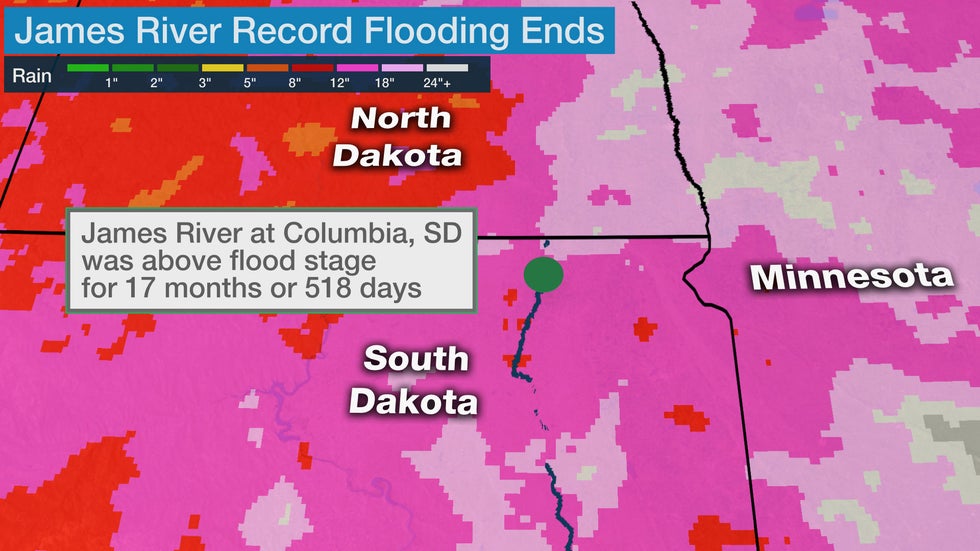Linda Lam and Chris Dolce
A South Dakota river finally fell below flood stage Monday for the first time in a record 17 months.
Flooding of the James River at Columbia, South Dakota, was first triggered after a bomb cyclone hit the Plains in March 2019. Heavy rain and snowmelt led to record high river levels and major flooding across parts of the region, extending into parts of Iowa and Nebraska.
The Columbia river gauge reached major flood stage in spring 2019 and crested at 18.96 feet on April 21, 2019.
 Record river flooding occurred on the James River at Columbia, South Dakota, from March 2019 through August 2020. The contour on the map depicts how much rainfall has been observed so far in 2020, as of Aug. 31.
Record river flooding occurred on the James River at Columbia, South Dakota, from March 2019 through August 2020. The contour on the map depicts how much rainfall has been observed so far in 2020, as of Aug. 31.Six river gauges on the James River in eastern South Dakota were above flood stage for at least 300 days and two river gauges were above flood stage for more than a year. All of these gauges set records for flood longevity.
The river gauge at Columbia, South Dakota, led the way for the most consecutive days above flood stage.
The streak began on April 2, 2019, weeks after the bomb cyclone hit the Plains. This gauge remained above flood stage until Monday – 518 days later. The previous record at this gauge for continuous days above flood stage was 266, observed in 2011. This new record almost doubled the previous one.
Wetter-than-average conditions continued across much of the region throughout 2019, which led to the persistent river flooding. North and South Dakota experienced the wettest year on record in 2019.
However, drier conditions developed this year, which allowed flooding to finally recede.
Most of the areas impacted by the recent James River flooding have been confined to low-lying and/or rural and agricultural areas.
The James River flows into the Missouri River at the border between Nebraska and South Dakota. From there, its waters head into the Mississippi River and eventually the Gulf of Mexico.
Heading into fall 2020, drier-than-average conditions are expected for September in the Northern Plains, according to NOAA's Climate Prediction Center. This drier trend should allow a break from the river flooding for at least a while.
The Weather Company’s primary journalistic mission is to report on breaking weather news, the environment and the importance of science to our lives. This story does not necessarily represent the position of our parent company, IBM.
The Weather Company’s primary journalistic mission is to report on breaking weather news, the environment and the importance of science to our lives. This story does not necessarily represent the position of our parent company, IBM.

No comments:
Post a Comment